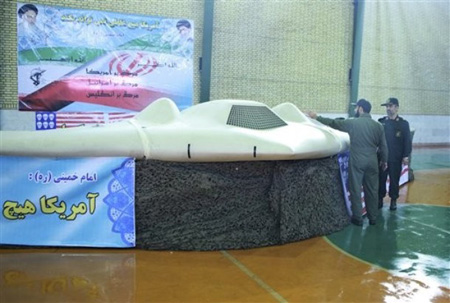By Mark Hosenball and Andrea Shalal-Esa

The unmanned RQ-170 Sentinel drone, which had been on a sensitive CIA surveillance mission over Iran, crashed and was apparently reassembled by Iran before being put on display in Tehran, said one of the officials, who was speaking on condition of anonymity given the sensitive nature of the investigation.
While exactly what went wrong with the aircraft is not publicly known, it is now becoming clear that its operators could have crashed the plane and destroyed it if they had taken action while it was still at a higher altitude, according to a source familiar with the aircraft and its operation.
Instead, the stealthy drone built by Lockheed Martin Corp broke up into several large pieces, allowing Iran to reassemble the plane and possibly share some of its technological secrets with China, Russia or other U.S. competitors.
Once the plane, built by Lockheed Martin Corp, dropped to a low enough altitude, its aerodynamic design made a catastrophic crash impossible, said one person familiar with the plane’s design and operating procedures.
Pilot error has not been confirmed, but it is one of the causes under examination, according to the two officials.
The new information explains why the drone was not destroyed and instead fell into Iran’s hands in an incident that has significantly heightened tensions with the United States.
Iran announced on December 4 it had downed the spy plane in the eastern part of the country, near Afghanistan. It has since shown an image of the apparently intact plane on television and said it is close to cracking its technological secrets.
Iranian officials have variously claimed they shot the plane down, or duped it into landing by resetting its navigational information.
The incident was the latest in a series that have escalated a confrontation between Iran and the West, which accuses the Islamic Republic of trying to develop nuclear weapons. Iran denies that charge.
U.S. President Barack Obama has asked Iran to return the drone, but Iranian officials say they do not plan to give it back.
U.S. officials, speaking on condition of anonymity, have confirmed the plane was on a CIA surveillance mission over Iran, but adamantly deny Iran shot it down, or brought it down through computer hacking.
Early on, officials said it likely suffered a technical malfunction, but this is the first time officials have raised the possibility of pilot error.
Lockheed has confirmed it makes the RQ-170 drone, which came out of its secretive Skunk Works facility in southern California, but is referring all questions about the current incident to the Air Force, which first acknowledged the existence of the drone in December 2009.
The plane measures over 40 feet from wing tip to wing tip, and carries a full-motion video sensor that was used this year by U.S. intelligence to monitor al Qaeda leader Osama bin Laden’s compound in Pakistan ahead of the raid that killed him.
The main concern about technology Iran could pilfer from the drone centers on special coatings on the craft’s surface that make it largely invisible to radar.
The computers onboard the drone are believed to have been heavily encrypted and its sensors were not the most sophisticated tools in the U.S. arsenal.
The United States and other Western nations tightened sanctions on Iran last week and Britain withdrew its diplomatic staff from Tehran after hard-line youths stormed two diplomatic compounds.
The United States has not ruled out military action against Iran’s nuclear facilities if diplomacy fails to resolve a dispute over the program, which Washington believes is aimed at developing atomic weapons.
(Reporting By Andrea Shalal-Esa)